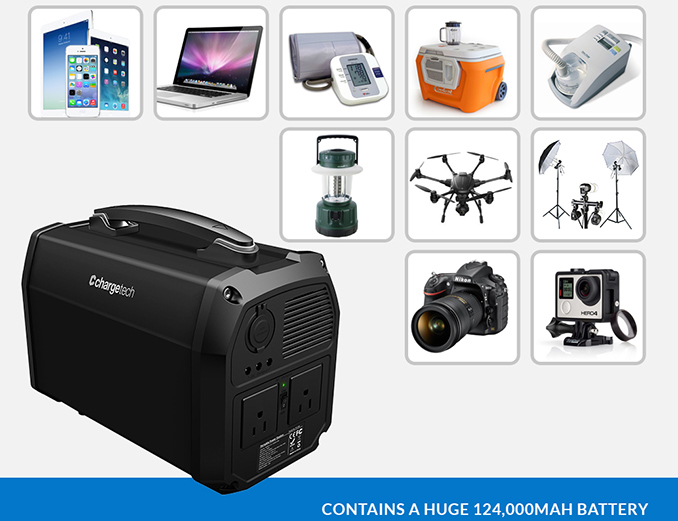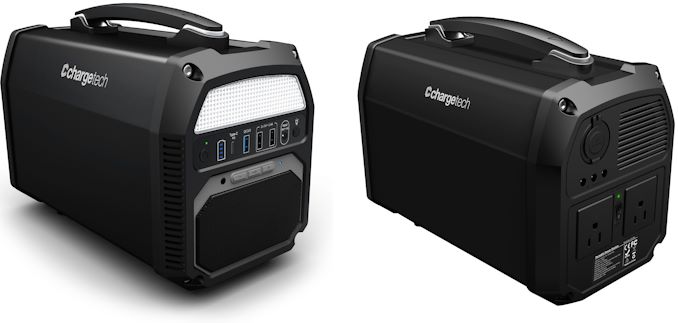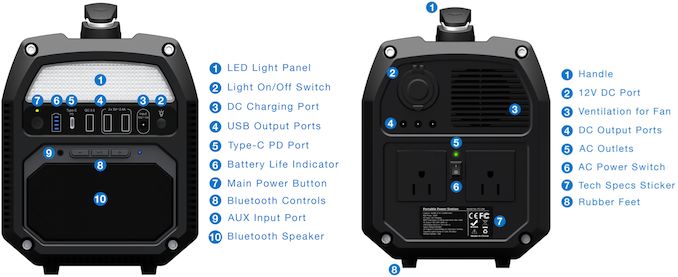ChargeTech 124,800 mAh Battery Pack: Charge Your iPhone 47 Times
by Anton Shilov on February 23, 2019 9:00 AM EST- Posted in
- Power Bank
- ChargeTech

One of the fundamental elements of a backpack when going on a journey is to take a battery pack in case your smartphone doesn't make it through the day. These devices typically hold from 5000 to 20000 mAh and can charge a device a few times. For example, my 11300 mAh battery is rated at 42.7 Watt hours, and often the legal limit on aircraft is 100 Watt hours. Now imagine we scale that into something the size of a portable amplifier, that can charge laptops as well. These bigger battery devices has been around a while, varying in size and shape, but ChargeTech believes it has a nice sweet spot.
Its new 'portable power station' features a 124,800 mAh capacity battery, which comes in at 462 Wh. This large battery pack, which won't make it past the TSA, is designed for charging devices where there is no extra power, or for long journeys in the wilderness where power is a must. If a user needs to power many devices when away from a power grid, it features AC outlets, DC power connectors, USB Type-A, and USB Type-C ports. Furthermore, it can playback music, and has an LED light to illuminate surroundings as well.
The ChargeTech PS120K packs multiple batteries for a total capacity of 124,800 mAh (462 Wh), which is enough to charge a typical 13.3-inch laptop for 10 times, or Apple’s iPhone XR 47 times. Obviously, the product can do much more than that. It has two 110-120 Volt AC power outlets that can deliver up to 300 W each, three DC 9-12V/5A power outlets, a cigarette lighter port, three USB Type-A ports, and a USB Type-C port supporting 60 W power delivery (see exact specs in the table below). It requires its own special power supply to charge it, which is not built in to the device.
As two added bonuses, the unit features a 10 W Bluetooth speaker as well as a massive LED array that can light up surroundings or even display SOS signs.
| The ChargeTech PS120K 110V only |
|||
| Port | Output | Input | |
| DC Input | - | 19V/4.5A = 85.5 W via power pack |
|
| AC Power Outputs | 2 × 300 W | - | |
| DC Power Outputs | 1 × 9-12V/5A = 60 W | - | |
| USB Type-A with QC 3.0 | 1 × 18 W | - | |
| USB Type-A | 2 × 2.4A/5V = 24 W | - | |
| USB Type-C | 60 W PD | - | |
| Cigarette Lighter Port | 1 × 9-12V/5A = 60 W | - | |
| General Features | |||
| Total Capacity | 462 Wh 3.7V 124,800 mAh |
||
| Bluetooth Speaker | 10 W | ||
| LED Light | 5 W | ||
| Weight | 12 lbs / 5.4 kg | ||
| Price | $699 | ||
ChargeTech recommends the PS120K to those going to road trips to rural areas and who might need to charge smartphones, laptops, cameras, drones, and other gear. Naturally, the device can be used by various professionals to charge equipment they take on set. One thing to keep in mind that the product cannot be taken onboard of commercial airlines. In the meantime, the manufacturer does not position its portable power station for first responders and other people working in extreme conditions all the time (this does not mean that it cannot be used by them at all, but it just does not have certifications for extreme conditions).
ChargeTech will start sales of its PS120K portable power station in March 2019 at a price of $699.
Related Reading
Source: ChargeTech












32 Comments
View All Comments
Samus - Sunday, February 24, 2019 - link
Opencg. Wattage has nothing to do with it.I've jump-started a car off my R/C shortcourse truck battery. It's a cheap $25 5000mah 11.1v nominal (peak is well above the 12v necessary to crank a starter motor) and it's the size of a pack of cigarettes. The catch is it is rated at 50C; it can output 50x its rated capacity in a burst. Even cheap LiPo packs are rated at 25C which supplies the 125amps to jump-start a car on a mildly dead battery. These packs usually charge at 5C but good packs can charge at 10C (which means they can recharge in a few minutes from a capable charger.)
You need to understand the underlying chemistry used here. Lithium Ion, Polymer and even tiny LiFE cells can all jump-start a vehicle as is if they have the required discharge rating.
That said, even if they didn't want to use capable quality cells (which they SHOULD for $700!) they could use an amplifier in the form of a super capacitor or a separate low amp trio of lithium cells to supply the necessary current to turn over an engine. I think this is a very useful feature, especially for a device like this.
Ashinjuka - Saturday, February 23, 2019 - link
Always good to see LRF support on these types of devices.close - Saturday, February 23, 2019 - link
"The ChargeTech PS120K packs multiple batteries for a total capacity of 124,800 mAh (462 Wh), which is enough to charge a typical 13.3-inch laptop for 10 times, or Apple’s iPhone XR 47 times"Back of the napkin math doesn't really apply well. Not only will the 124800mAh pack only charge the 2942mAh iPhone XR battery just 42.5 time but also the battery capacity is lower the higher the discharge current. And lithium batteries are notoriously bad at this. You can easily lose 20-25% of the capacity just by increasing the discharge current.
The C value (Capability, the higher it is, the more current you can draw without significantly lowering its capacity) is much better for a lead acid battery, at the downside of about twice the weight.
So for people taking it to charge their phone 45 times it may work better than for those who assume they can power a lot of devices at the same time using the same math. This should be good to know for people to properly adjust their expectation to the use case.
Death666Angel - Saturday, February 23, 2019 - link
Huh? That's not how the C rate works. C is the capacity of the battery (any battery type). With most batteries, it is advisable to not charge them at a current larger than 1 C, for longevity sake. It is also advisable to not discharge them at unreasonable C rates. Many new lithium batteries are designed for certain tasks (car starter battery, drone flying) where high C-rate discharge is important, so they come with 30C, 50C, 100C ratings. Some people also don't want to wait a long time to recharge their battery, so they are fine at charging at 5C for a reduced cycle life. If a 50C batteries get discharged in a drone and lands when the drone indicates it only has 3.1V left (3.0V is generally the level at which you want to stop draining your lithium battery, non-standard chemistry not withstanding), it can easily get back up to 3.7V when you apply a simple 500mA discharge current to charge your phone (let's say this is a 5000mAh battery, so a 0.1C discharge rate). But try using it for a 10C application it won't let you until you recharge it again (the voltage will collapse immediately).Lead acid batteries are just as general as lithium ones. You have car batteries which have huge amperage (C-rate in your example), but really bad deep discharge functionality. And then you have ones that are used in UPSes that offer fine discharge rates (less than car batteries) but great deep cycle stability. It's not at all how you describe it, unfortunately.
This is why capacitors are the future of electric mobility, not batteries. But that's beside the point. :D
close - Sunday, February 24, 2019 - link
I thought I was pretty clear about what I meant. Let's keep it simple this time: a battery will have lower capacity the faster you discharge it (the higher the C rate, the lower the energy and capacity). I'm not talking about exceeding load limits. I'll let the experts speak now:https://www.panasonic-eneloop.eu/en/capacity-not-c...
"The available capacity of a battery depends upon the rate at which it is discharged."
"A battery rated at 100 Ah will deliver 5 A over a 20 hour period at room temperature. However, if it is instead discharged at 50 A, it will run out of charge before the theoretically-expected 2 hours."
I tested this myself with my regular RAV Power and Anker powerbanks (all under ~30000mAh) although I didn't really need to validate physics. The capacity was 10% lower with 2.4A vs. 1A discharge. And this is while starting with ~65-75% usable capacity anyway. It appears that the increase in temperature and thus in voltage does not compensate for the increase in resistance.
Since the battery in the article is obviously meant for heavy duty use, not charging one phone, these figures would have been relevant. I'm willing to bet this doesn't actually go over 100000mAh and will be less than that when discharging it rapidly (perhaps no more than 80000mAh).
Sonic01 - Saturday, February 23, 2019 - link
meh, i built my own 600wh battery yesterday for £40, using some recycled broken laptop batteries. took 3.5h to build. $700 for one sounds crazy after that XDpiroroadkill - Saturday, February 23, 2019 - link
The advertising picture notes "MAH", which would clearly mean mega-amp hours, not milli-amp hours. SI prefixes are very case sensitive. Also, this whole amp-hour marketing makes no sense, because it's based on a voltage of 3.7. We need to get away from it. Way away from it. Wh is what we need, at least.Death666Angel - Saturday, February 23, 2019 - link
All it does is save you one multiplication. And I'm sure some Chinese vendors will fuck that up again as well.mkozakewich - Sunday, February 24, 2019 - link
No, if we're using mAh then people really want the numbers to be comparable. I've already seen a tablet with a 7.4v battery double its mAh to make a "3.7v equivalent" number. If they were using watt-hours, they wouldn't have had to do anything special.Especially considering this kind of equipment: Usually we use 12v car batteries to make portable power sources with inverters, and this box has the same 400-500 Wh despite the huge mAh number.
yannigr2 - Saturday, February 23, 2019 - link
Why not use a much cheaper,or two, UPS?